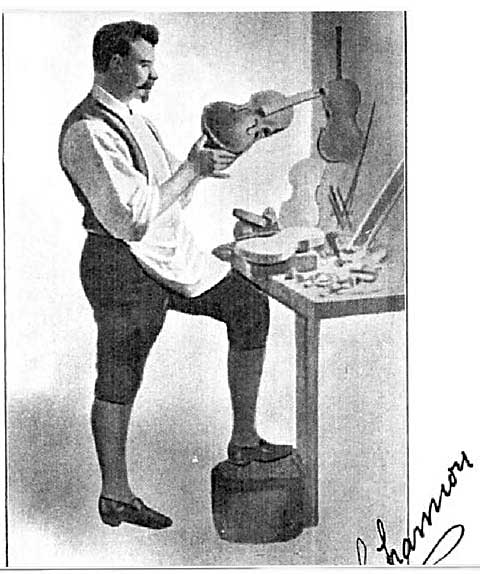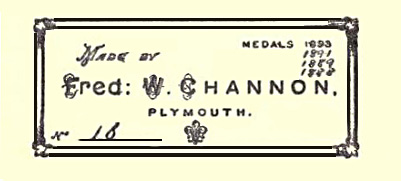Channon F.W. Cabinet and Violin Maker
If you ever come across a violin made by Channon of Devonport you can be sure it
is a fine instrument, and recognised as such by both musicians and the antique market,
for Channon is recorded as one of the best and most esteemed of British violin makers
of his day.
I've transcribed below text from two books that mention Channon, one written 1893 the other 1920. As a tribute to Channon I wanted to
sing his praise and tell you more about him, but these writers have done that better than I could, so here are their words.....

Image of Channon at his work in Devonport, from the book
British Violin Makers... 1920. The signature is probably a facsimile of his own.
Source 1. Industrial Great Britain... 1893
from pages 184-185
Mr. F.W. Channon, Art Cabinet and Violin Maker,
40, Cumberland Street, Devonport
The business of cabinet-making has a special interest for the writer on the industries
of a certain district, and we may safely say that, in the town of Devonport Mr.
F. Channon takes a leading position in the cabinet trade, and it gives us pleasure
to make special mention of his work in these pages, as his business is not only
important but, we unhesitatingly assert, unique of its kind in the three towns.
We refer especially to that part of the business which is devoted to the peculiar,
interesting, and intricate art of violin-making.
Cabinet making. Brought up by
the celebrated firm Dart’s, of Totnes, and having acted for three years as foreman
at Messrs Graves & Sons, of Devonport, Mr Channon in 1886, established the above
works, and has creditably identified his name with high-class work in art cabinet-making.
American walnut richly inlaid is one of his specialities, admirable alike for beauty
of material, accurate construction, and delicate and faultless finish. Mr Channon
is an artist as well as an artisan, and his designs are on a par with his workmanship,
all being characterized by superior elegance and taste. His practical qualifications
are of a high order, and he is well known throughout the county as a technical instructor,
teaching every department of the woodworker’s art with thoroughness and skill. He
has obtained certificates of merit, first-class bronze and silver medals from the
Royal Polytechnic and other exhibitions, to which testimony no words of ours can
add. We strongly recommend a visit to his newly built and commodious works.
Upholstery.
Upholstery is, of course, a branch in which Mr Channon is experienced. All materials
used are of the best; hair perfectly new and clean; springs of the most approved
shape and size; coverings are the best that can be supplied.
French Polishing. By using only the purest gums in the making of his polishes, he is able to insure
its transparency and durability.
Furniture Reviver. After years of research, Mr.
Channon discovered his celebrated Instantaneous Furniture Reviver, which produces
an effect in application that entitles it to be termed the best reviver in the market,
and has received awards wherever exhibited.
Violin Making. Mr. Channon has achieved
great success in violin-making, and he considers this branch of his work a speciality.
His extraordinary success with his first violin, bow and fittings – made under the
direction of Mr F. Codd of Devonport, certified by him as of excellent tone and
purity, and awarded a silver medal at the 1893 Royal Polytechnic – induced him to
establish a thoroughly equipped workshop. Here we find several instruments in course
of construction, together with some valuable old ones entrusted to Mr. Channon’s
skillful hands for repairs, for which he is largely patronized by the leading professionals
in both counties. Here also are models from the great makers, and a large stock
of well-seasoned and selected woods. Not only is he capable of repairing the most
valuable and delicate instruments, but he has, after many experiments, obtained
an oily varnish which gives the greatest possible satisfaction, and may in after
years prove famous. His resin is purer than that obtained in the usual way. Strings
and all necessary fittings, in fact, a complete violinist’s outfit, can be supplied.
Mr Channon conducts his business with conspicuous ability and enterprise, and has
the confidence and support of an influential and growing connection in this part
of the country.
Source 2. British Violin Makers... 1920
page 20/21...
Since about the year 1850 the British School of Violin-making may
truly be said to have accomplished the most complete
of its avatara, or incarnations: it has been born
again - born, I verily believe, to a higher and fuller
manifestation of life.
We have now working amongst us Atkinson, Byrom, Channon, Chanot, Darbey,
Gilbert, Hesketh, Keenan, Owen, Richardson, Withers, etc., much of whose work will,
I venture to think, be highly esteemed a century hence.
page 22... Atkinson Channon, Gilbert and one or two others among professional makers,
mostly work on models of their own.
page 31... A very beautiful varnish is produced by Mr. F.W. Channon, a clever and
well-known professional violin maker, of London. Unlike the majority of professional
makes he does not attempt to make a mystery of its composition or of the method
of its preparation; on the other hand, he readily reveals both. With his kind permission
I am allowed to say here that he is prepared to furnish his formulae with full instructions
to any
bone fide violin maker.
page 118...
CHANNON, FREDERICK WILLIAM, London. He works at present at 54 wells Street, Oxford
Street, as a professional maker and repairer, but up to about two years ago he lived
in Plymouth, where he had been established for many years as a professional maker.
He was born at totnes, in 1862, and apprenticed in early life as a cabinet maker.
He made such rapid progress at his trade that at the age of twenty-one he became
forman of one of the largest cabinet shops in Devonport, with about thirty men and
apprentices under his charge. At the age of twenty five he commenced business on
his own account, and he was appointed at the same time technical instructor in carving
and carpentry to a local institution.
He commenced to make violins in 1887, first
as a hobby and during spare time in a year or two he resolved to give up all other
work and devote the whole of his time and energy to the art of constructing and
repairing violins. That he decided wisely is abundantly proved by the very beautiful
work he now produces. He is in the foremost rank of present day makers, and it is
a pity that so much of his time is taken up with repairs.
Repairing is, of course, of great importance, demanding intelligence and skill,
but it is a loss that craftsmen with a special gift for designing and making have
to devote the best energy of their life to it.
page 119...
In his earlier work Mr. Channon adhered strictly to the grand Strad model, but latterly
he has worked on a model of his own, the principal measurements of which are 13
63/64. 6 36/64, 4 16/64, 8 10/64, the three last fractions may, of course, be expressed
in 32nds). The sound-holes are 3 inches, and the C’s 3 3/16 inch long. The thickness
of the back is 3/16 diminishing to 1/8, and the table is 1/8 all over. The outline
of this model is simple and graceful the curves of the C’s as they approach the
corners being not quite so pronounced as in the Strad model, and the linear difference
in the width across the upper and lower bouts is not so great as in the grand Strad.
Viewed as a whole the outline is well balanced, and the curves easy and proportionate.
The scroll and sound-holes are of Stradivarian character, beautifully designed and
placed, and the corners are full without being obtrusive. There is a sense of gentle
restraint about the model that is very pleasing to the trained eye. Violin makers,
especially beginners, frequently break out into original models, and where the hand
and the eye have not been severely trained, there is little control over the curves.
To produce a perfect model (using the word model here to include outline and arching)
due regard must be paid to five cardinal principles: unity, repose, symmetry, purity,
moderation. Only he who is able to combine these five principles and to express
them in forms can design a perfect violin model. Symmetry and moderation are often lacking
in the corners of modern fiddles. There was much solidity and withal moderation
and repose in the quaint and quiet corners of old Maggini. When Stradivari waked
those corners of their slumber in his own work, he did all that pure art dare do.
Many of his imitators have added two pairs of miniature winds to their instruments,
and the result is grotesque.
Mr Channon has not only succeeded in producing a beautiful model: he also produces
a fine tone. After all, the tone is the chief thing, and all the skill and care
lavished on the workmanship would be energy wasted if the tone did not come out rightly.
Artists who use his instruments say that the tone is rich and mellow, easy to get,
and equal on all the strings. The following facsimile is that of the label used by
the maker while working in Plymouth: the word “London” being substituted for “Plymouth”
in the one now used.

Image of Channon's label, from page 120 of
British Violin Makers... 1920.
By the outbreak of WWI, Plymouth, Devonport and Stonehouse had amalgamated, the three towns became one. Channon was listed in the 1914 Directory of Plymouth, Stonehouse and Devonport
as ... CHANNON Fredk William, Violin maker, 28 Tavistock place, Plymouth.
That was the last time Channon was mentioned in any Plymouth or Devonport directory; he must have gone to London during the war period as he was there by 1920.
Sources:
[1]
Industrial Great Britain: A Commercial Review of Leading Firms Selected
From Important Towns of England with Illustrations of England's Prominent Edifices.
Historical, Statistical, Biographical. 1893.
London Printing and Engraving Company, 53
& 54, Chancery Lane, London.
Book: A Victorian business survey reviewing shops and premises, both large and small, operating
in the provincial Britain of the late nineteenth century.
[2]
British Violin Makers; a biographical dictionary of British makers of stringed
instruments and bows and a critical description of their work, with introductory
chapters, and numerous portraits and illustrations. MORRIS W. Meredith. Publisher:
London, R. Scott. 1920
Available from
http://www.archive.org/details/violinmakersbrit00morruoft
Accessed January 2012
(page added January 2012)